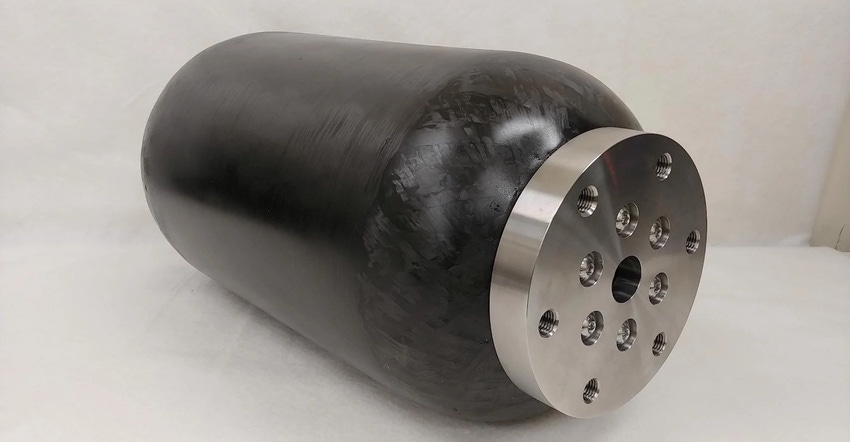Lockheed Martin Turns to Aussie for Liquid Hydrogen Storage and Transport Technology
Nano-engineered composite tanks will store cryogenic liquid propellants for commercial and civil satellite programs.
July 6, 2021

A partnership between Lockheed Martin, Australian manufacturer Omni Tanker, and the University of New South Wales (UNSW) will look to develop and commercialize world-first composite tank technologies, thanks to a grant from the federal government’s Advanced Manufacturing Growth Centre (AMGC). The co-funded project, announced as part of AMGC’s Commercialisation Fund launch and worth a total $1.4 million, will utilize two technologies to solve the challenges of using composites for the transportation and storage of liquid hydrogen with applications on the ground, in the air, underwater, and in space.
Combining nano-engineering technology developed by UNSW in partnership with Lockheed Martin and Omni Tanker, and Omni Tanker’s patented OmniBIND technology, the collaboration will result in the development of two new operational-scale propellant tanks for storing cryogenic liquid fuels for commercial and civil satellite programs: a Type IV fluoropolymer-lined carbon-fibre-composite tank and a Type V linerless carbon-fibre-composite tank. Both are suitable for high-pressure applications and the extreme cryogenic temperatures required for liquid hydrogen as well as oxygen, hydrogen peroxide, and hydrazine.
Christopher Hess, Head of Industrial Development, Lockheed Martin Australia, acknowledged the support of AMGC and welcomed the opportunity for ongoing collaboration with UNSW and Omni Tanker. “Lockheed Martin invests millions of dollars every year into R&D programs with our Australian industry and research partners to solve real challenges facing our global supply chains,” he said. “We have had a longstanding research collaboration with UNSW and Omni Tanker, and we are grateful for the support of the AMGC as we now look to commercialize these cutting edge, Australian-developed composite tank technologies for a number of Lockheed Martin and NASA applications.”
David Ball, Regional Director Australia and New Zealand, Lockheed Martin Space, said the development of composite tanks that are lightweight, cost-effective, and resistant to microcracking and permeation represents a unique and innovative technological solution with significant space applications. “As the world increasingly looks to hydrogen for emission-free energy, containing and transporting it in a safe, cost-effective, and economic manner remains extremely challenging,” he said. “The space industry is particularly interested in the development of linerless composite tanks for their weight efficiency and durability, the cutting edge of composite pressure vessel manufacturing.
“These advances have the potential to support the growth of Australia’s sovereign space capabilities, strengthen exports to space-faring allies and partner nations, and make an important technological contribution to future space missions, particularly in on-orbit storage, launch, and deep space exploration,” he said.
“Creating a lightweight vessel for transporting liquid hydrogen at minus 253 degrees Celsius is no simple thing — whether you’re moving it along a highway or to outer space — but it’s Australian know-how that is making it possible,” added Dr Jens Goennemann, Managing Director, AMGC. “That’s why AMGC is supporting Omni Tanker and its collaborative partners to engineer and manufacture a solution to this problem and offer it globally,” he said. The project builds on a recent invention by the research team at UNSW led by Professor Chun Wang, which enables carbon-fiber-composites to withstand liquid hydrogen temperatures without matrix cracks, a challenge that has, up until now, prevented mass-market adoption of these materials for such applications.
Omni Tanker, with its significant experience in the development and commercialization of strong, lightweight composite transport vessels, has the know-how and technology to translate the recent research innovations into myriad applications. Omni Tanker’s CEO, Daniel Rodgers says: “This next phase in our collaboration with Lockheed Martin and UNSW is a landmark development that sees Omni Tanker’s seamless thermoplastic lining technology enter the aerospace sector. The OmniBIND technology has made inroads to revolutionizing the safe and efficient movement of challenging liquids within the chemical transport sector. Now the growing need to decarbonize the energy industry, and the reusable low-earth-orbit satellite market, have the potential to drive major utilization for these new technologies.”
About the Author(s)
You May Also Like


